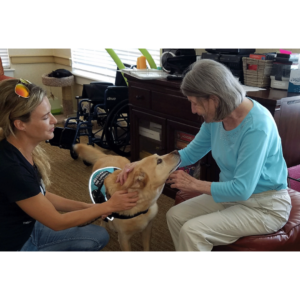Pet Therapy and Elder Care: A Winning Combination
For many people, pets are more than just animals. They’re life companions who provide unconditional love and comfort. They can also offer significant health benefits. Frequent contact with pets has been shown to improve cognitive abilities, enhance mood, and boost feelings of interest and enthusiasm.
What is pet therapy?
There are various types of pet therapy. Some common examples include:
- Animal-assisted therapy. Residents of nursing homes are paired with a trained animal to accompany them throughout their therapy. Animal-assisted therapy is recommended for individuals who require an intensive rehab regimen.
- Visitation therapy. The pets visit the elderly in nursing homes and hospitals. This allows the residents to enjoy the presence of the animals without the added responsibility of looking after them.
- Ownership therapy. A form of pet therapy where one or more residents takes full responsibility for the pets. This type of therapy requires a thorough evaluation of the resident’s physiological and psychological capabilities.
What are the benefits of pet therapy?
Pet therapy provides a host of benefits, including:
- Improved self-esteem
While living at a nursing home, elderly people can be vulnerable to low self-esteem. This is particularly true for seniors who miss independent living and the consistent presence of family.
Introducing a bubbly pet into their lives can be a tremendous help in improving their self-esteem because pets can provide a sense of renewed purpose and inspiration. Interacting with the animals also reduces feelings of loneliness.
- Lower levels of stress and depression
Residents who’ve spent a long time in a nursing home can be susceptible to feeling down and depressed due to a lack of social interaction. Pets can serve as a healthy distraction for seniors by giving them meaningful interaction. They can also help lessen stress levels by diverting attention from worries and concerns.
- Increased physical activity
Pets are active—they need to be walked, fed, and played with. All of these activities can help boost the physical activity of the elderly residents and stimulate both their minds and bodies. If the residents are undergoing any exercise programs, pets can often be incorporated into the routines to make the workouts more fun and exciting. Even a brisk walk is more fun with a pet along for the outing.
How to introduce a pet into nursing homes
While many seniors are delighted by the presence of pets, not everyone welcomes the idea. Thus, it’s crucial to discuss pet therapy with residents and their families first, before a pet is introduced into the facility. The nurses and caregivers should be willing to shoulder the responsibility of looking after the pets and ensuring the animals and the residents coexist positively.
Before introducing a pet into a nursing home, here are a few things worth considering:
- Introduce the right pets. Animals have different energy levels and so do the elderly. A young dog is more suited to a resident with high activity levels, while an indoor cat may be suited to someone who prefers less physical activities.
- Consult the relatives of the residents. Ask them if they are OK with the idea of visiting with a pet and having their loved ones undergo pet therapy.
- Ask about allergies. The last thing you want is to trigger an allergy while the elders are interacting with the animals.
- Hire a pet therapist from a professional company to provide animal-assisted therapy to the residents.
Many nursing homes, including Homestyle Aged Care, have started to adopt pet therapy because of its myriad benefits. Having pets around can help improve the residents’ quality of life and provide them with a great deal of fulfillment and joy.

Daniel Lummis is a marketing consultant with Homestyle Aged Care, which operates a number of aged care facilities throughout Melbourne, Australia.
Related Articles
Topics: Activities , Alzheimer's/Dementia , Facility management , Featured Articles , Rehabilitation , Resident Care , Senior Environments











